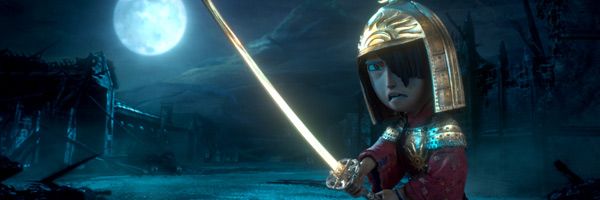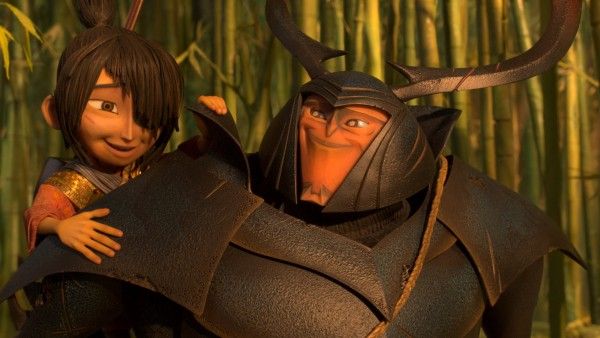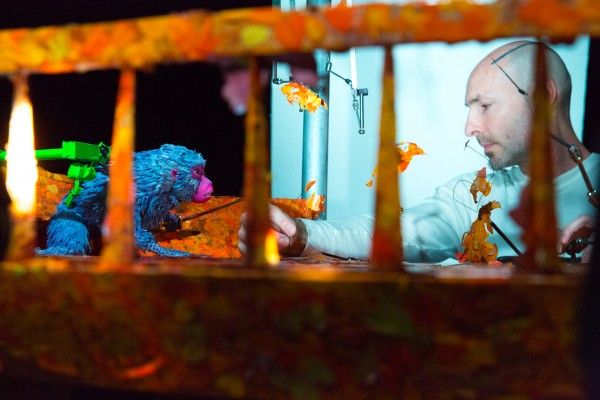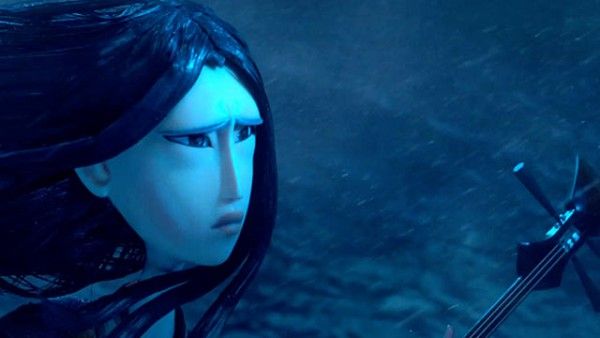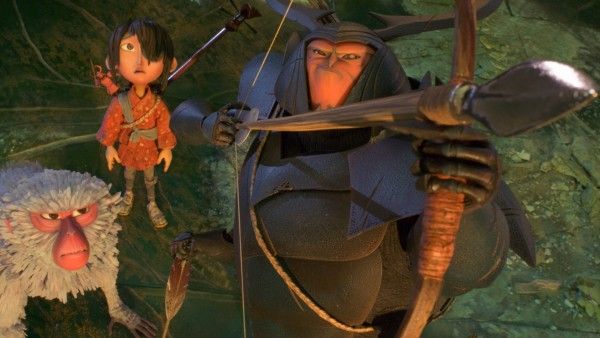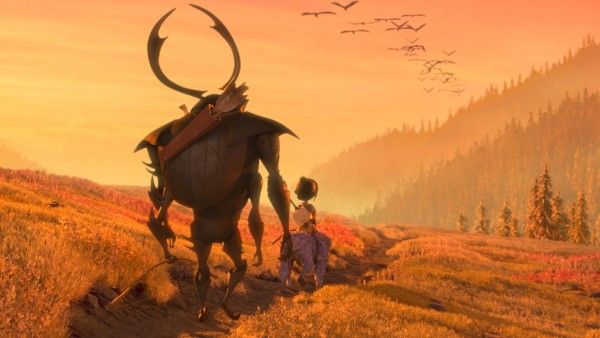From animation studio Laika and directed by President and CEO Travis Knight, Kubo and the Two Strings is an epic action-adventure story set in a world of wonders. In fantastical ancient Japan, a boy named Kubo (voiced by Art Parkinson) uses his magical gift for spinning wild tales out of folded origami to mesmerize the townspeople while also caring for his fading mother. After accidentally summoning a spirit that must enforce an age-old vendetta, Kubo goes on the run and joins forces with the fierce Monkey (voiced by Charlize Theron) and the samurai Beetle (voiced by Matthew McConaughey) to solve the mystery of his legacy, reunite his family, and find out just what it means to be a hero.
During a conference at the film’s press day, actors Charlize Theron and Matthew McConaughey were joined by director Travis Knight to talk about why this film fit in with the goals of Laika, what most strongly influenced the storytelling, exploring new and original ideas, mentors that have played a role in their own lives, their first exposure to animation, the stop-motion animation process, and the lessons that kids might learn with this story.
Question: Travis, what was it about this screenplay that fell into line with the goals of Laika?
TRAVIS KNIGHT: We started Laika about ten years ago, and we had a pretty simple mandate, which was to make movies that matter, to tell stories that were rich and evocative, were thematically challenging, and had something meaningful to say about what it means to be human. We always want to do new, interesting stories and explore different aspects of the human condition. This story really spoke to me because when I was a kid, I loved big epic fantasies, and that’s what this film is. At the same time, when I was around eight years old, I went to Japan, for the first time. I was a kid that grew up in Portland, Oregon, so being in Japan was unlike anything else I had ever experienced. It was a real revelation for me. It’s a kind of art that’s lived with me, for my entire life. So, this film really ticked those boxes for me.
How much did Akira Kurosawa and Hayao Miyazaki influence this film?
KNIGHT: We draw inspiration from a lot of different places, but probably the two biggest film influences were Akira Kurosawa and Hayao Miyazaki. It was the way that Kurosawa made films, which was with this incredible composition, cutting, staging, lighting and his work with shapes. But it was not just the way he made films, it was what he made films about. He always explored something really meaningful, like existentialism and humanism. He always explored different aspects of what it means to be human, in the human society and human family that we live in, and that was an important aspect of what we did in this movie. I’ve been a fan of Hayao Miyazaki for 20 years. Miyazaki has a half a dozen films that were either inspired by or set in Europe, and I love the way he internalizes, synthesizes, and then weaves into his own art, different cultural influences. The same kind of prism that Miyazaki applied to Europe was what we wanted to apply to Japan. That same vitality and love for this incredible culture, we tried to apply to Japan in this movie.
Charlize and Matthew, after having done the voice work without getting to see the animation, what did you think of the finished film?
CHARLIZE THERON: I absolutely loved it! The first moment that I met Travis, when we started having a conversation about this, there was something very clear about what he was trying to set out to do. I think it was finding a way to tell a story through great character, but also through a real sense of the world. It was very hard for him to talk about character without talking about world. And to finally see the film and see the celebration of both of those things, so beautifully and seamlessly done, I was just so inspired by it, really. I have such admiration for the time and the patience and the passion that has to go into that. As actors, we step in and the embodiment is in broad strokes. With this, it’s painted with such a small brush that’s such a find brush, and I am just in complete awe of what that is. And on top of all of that, the story is incredibly moving, and really layered and conflicted, and covers a lot of things that we are sometimes scared to address with children. It’s so true to what Laika stands for and what their films have represented, in the sense that thematically, there really isn’t anything that you can’t explore, in an interesting way, through children’s eyes, and tell and teach them. I’m so happy to be a part of it. I never thought I would get to do something like this.
MATTHEW McCONAUGHEY: Laika before, and with this, has not really ever made material that pandered to kids. It’s never been, “Oh, that’s just a kids’ movie with kids’ themes.” There are always what’s considered adult themes, but that are things that every child can understand and digest. I watched it with my wife and my two eldest children, who are seven and five, and there were tears. I think my wife said she cried about nine times. And there was also laughter. The kids had tough questions afterward. They enjoyed the ride, but they came and asked. They were scared, at the right times, but they saw someone overcome fears. They wanted to talk about things in their own life. You don’t get that with every animated film. As adults, we quite enjoyed it, and the kids loved it. I think it’s a very impressive piece of work. When I met with Travis for the first time, we talked about how they do what they do, and I think it’s fully realized in the final film. I really enjoyed it.
Kubo learns life lessons from a few different characters in this film. Charlize and Matthew, have you guys had mentors or people in your life that you’ve learned from, in a way that has deeply impacted you?
McCONAUGHEY: The late Penny Lawson, who recently moved on about six months ago, was probably the best mentor I’ve had in my life. She wouldn’t call herself an acting coach, but that is what she was. She’s the lady who taught me what my rights could be, as an actor.
THERON: With me, there are so many. I’m so unbelievably fortunate to have had a lot of people come into my life, in very different ways and from very different places, some much younger and some much older. My life has been consistently blessed with people who have been great teachers to me. My mom was a consistent, through my entire life. I’m really lucky to have had a parent that was a great teacher, and still is a great teacher. I’m 40 and I’m like, god, I really thought this was going to end, at some point. There’s always some words of wisdom and I’m like, “Mom, wow, you just don’t stop!” And I’ve had a lot of people that you wouldn’t even know, who have come into my life, some of whom aren’t here now, that have molded me and my character in tremendous ways. I’m very grateful for that.
Travis, how do you top yourself with each Laika film?
KNIGHT: I don’t know that we really think about it that way. There is an inherent restlessness at Laika. We’re always looking for the next challenge. We always want to challenge ourselves as artists and we want to grow. The core team at Laika has been together for about ten years now, right from the start, and we’ve grown as filmmakers, as artists and as people. It’s almost like a family there. And the thing that excites us is to do something new and original, and to explore new ideas. So, because we stay together, each artistic and technological innovation that we come up with on any film, we can then apply to the next movie. When we started working on Kubo, it really did represent a seismic shift for us because we’d never really taken on anything of that scale in epic fantasy. The idea of making a stop-motion film on a tabletop that looks like a big, majestic vista is absurd, but we were excited by that challenge. It’s a testament to the creativity and the passion of the artists that they were able to pull it off. This film was unlike anything we’d ever done before, and our next film is the same way. We love to tell new stories, which unfortunately is a rarity in this business, nowadays.
Charlize and Matthew, what animated films did you discover when you were younger?
THERON: The first thing I can think of were those Looney Tunes. Television only came to South Africa in ‘75 or ‘76, so we were a little late to the game. Also, we only had about two hours of it a night, so it was very, very special. When I was 10 or 11, we got VCRs, and that was a game-changer for me. God, I’m so old, but I remember getting the BETA tapes of the Looney Tunes, and I remember that they were really short, eight-minute runs. As a kid, I could watch them over and over and over and over and over again, and not get bored. I would laugh at the same jokes and discover something new, at the same time. They still play them on the collective kid channels on cable, and every time I see them when my child is looking for something to watch, I secretly pop it on because I want to give him a little bit of what I had. He loves it, but what he has access to now is just so enormous. But for me, as a kid, that was my first experience with animation.
McCONAUGHEY: Maybe before BETA, I had to get up because we didn’t have remotes. I had to turn the three channels – CBS, ABC and NBC – with the ears up. I don’t think we were allowed a BETA. I didn’t watch much media growing up, but I do remember seeing Land of the Lost for the first time, on a Saturday morning. I remember the opening credits when they’d go off the end of the waterfall and into the world they end up in. The other one would be The Incredible Hulk with Lou Ferrigno. You knew he was going to get big and green, twice in the hour, at 7:22pm and about 7:41pm. And if there was an oxygen tank around, which there usually happened to magically be, he was going to throw it in slow motion and it was going to be awesome.
What did you think of the stop motion animation process?
THERON: I think we were all somewhat fascinated by it. I asked a lot of questions. The first time I went in, I knew nothing about it and was like, “So, is it like clay?” I was just so naive to the whole process, and that was what was so exciting to me. I’ve been doing this for longer than 20 years, and the idea of doing something that I logistically knew very little about was so refreshing. The part of the job that I had to bring to it, I was a little worried about, but Travis was so encouraging of me doing it. I didn’t want to F it up for him because I’d never done it. It’s a testament to why they’re so successful with the storytelling that they create and go after. It’s so grounded and real. Travis was constantly just really encouraging finding the truth and being a truth seeker during the entire process, which was quite long. I wouldn’t see him for several months, and then I would see him again and it would feel like you were picking up where you left off, but I didn’t see any of the animation stuff until there was a making of. I worked with some of the sketches moving, just to get an idea, but more than anything, I was working from Travis’ brain. He was my fountain of information. I really got my inspiration for what was needed to be painted on the canvas from him, and he’s very good at articulating that. What they do is so seamless that you forget the time, the effort, the talent and the passion that’s behind that. To just have a glimpse of that is a reminder that you’ve really watched something so incredibly special.
What are you hoping that kids get from this film?
McCONAUGHEY: For me, I’m always interested to see what lessons kids get from something that they watch. Charlize and I haven’t made much that our kids can watch, in a long time. I’ve had a lot of talks with my kids about courage and overcoming your fears, along the way. One of the themes of the story is that you’ve gotta fight and you’ve gotta have a lot of courage to write the third act of your story, to get your happy ending. It may not be exactly what you thought it was going to be, but usually, if you get to the truth of it, that’s a lot happier than not finishing the story, at all. You’ve gotta fight for your third act.
Do your kids recognize your voice in the character that you’re playing?
McCONAUGHEY: I took my family to go see the film and didn’t tell them exactly what I was doing or how I was a part of it. My wife was sitting next to me, my son was sitting to the right of me, and then my daughter was sitting on the other side of him. When the Beetle first came up, she leaned over and went, “Papa! Papa! That Beetle sounds a lot like you!” I just shrugged it off. And then, the second scene came up and she was like, “Papa, I’m telling you, that Beetle sounds like you!” So then, when the movie was over, she was like, “Was that you?” And I said, “Yes.” I was hot stuff around the house, for the next week.
THERON: The day that I saw it was my son’s first day back at school, so I felt wrong to pull him out to see the film, but I’m going to show it to him. He’s seen the trailer several times. He loves the trailer. He put it together and was like, “Mom, that sounds like you.” I didn’t want to bust it for him. I wanted him to experience the film for what it is, so I went, “Really?!” And then, his primary concern was that the world wouldn’t know that I wasn’t really a monkey. He was like, “Mom, you have to tell them that you’re not really a monkey.” That was really his only concern. I’m really excited for him to see it. He knows so much about it. I really made him a part of it. Travis is so tired of me talking about my little boy. This was something I really wanted to do for him, and I thought of him constantly while making this. I’m just really excited for him to see it.
Kubo and the Two Strings opens in theaters on August 19th.

